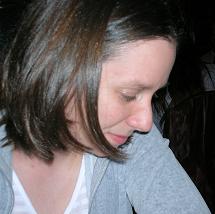Wednesday, July 02, 2008
A Far Better Rest, Susanne Alleyn
 This was ok. That's about it. It filled my need for "more French Revolution!" without getting me a few hundred pages into Les Mis, only to abandon it due to lack of time when getting to South Africa became foremost in my concerns.
This was ok. That's about it. It filled my need for "more French Revolution!" without getting me a few hundred pages into Les Mis, only to abandon it due to lack of time when getting to South Africa became foremost in my concerns.This is one of those spin-off books. It imagines the events in the life of Sydney Carton (from Tale of Two Cities) during the parts of the book where he disappears from the narrative. The bits of this novel that of necessity overlap with the action of Tale of Two Cities end up being a bit tedious, because, ok, I had just read Tale of Two Cities. The changed perspective in these parts of the narrative really didn’t add anything for me. I’ve ready plenty of novels & stories where shifting the telling of the same event to a different perspective adds new layers of meaning. This one didn’t really do that for me.
The bulk of the book is taken up with newly invented events, assuming that Carton moved to Paris and established himself in the middle of the political circles of the day. This part of the narrative was most interesting to me because it filled in some details of the political climate of Paris during the French Revolution.
However, I found it a little implausible. If Carton was well-known to such prominent figures as Robespierre, Marat, and Desmoulins, he would have been well-known enough in Paris that his likeness to Darnay would not have gone unnoticed. Kind of throws a wrench into the climax of the story. But (as with many historical novels) this author felt the need to thrust Carton into the middle of the action as far as French politics were concerned. I think this is one of the ways Dickens succeeds in the historical novel genre--he focuses on one group of people caught up in the events of history, rather than making them central to those events, or even adjacent to the people central to those events.
There’s a kind of amusing (to me) afterword/disclaimer at the end, which mildly argues that Dickens sensationalized the Terror and that it wasn’t so bad after all. The author compares the number executed during the Terror to the number killed during one of the Napoleonic battles. Small but important distinction that the author failed to draw out: those executed during the terror were, well... executed. Casualties of war are considerably different from executions carried out over a period of days and weeks. Executions ordered following hasty and dubious trials and convictions, I might add.
What I did enjoy in reading this was learning a bit more about the politics surrounding the time period that’s so central in Dickens’ novel. When I finished Tale of Two Cities, I was curious to read more about the same time period, and this novel did that--filling in some of the political details and context very well. While it was interesting for me to explore some additional fictional narrative focused on this historical time period, I wouldn’t exactly recommend this one heartily.
Labels: book review, fiction, reading
| posted by Barbara | 8:28 PM
